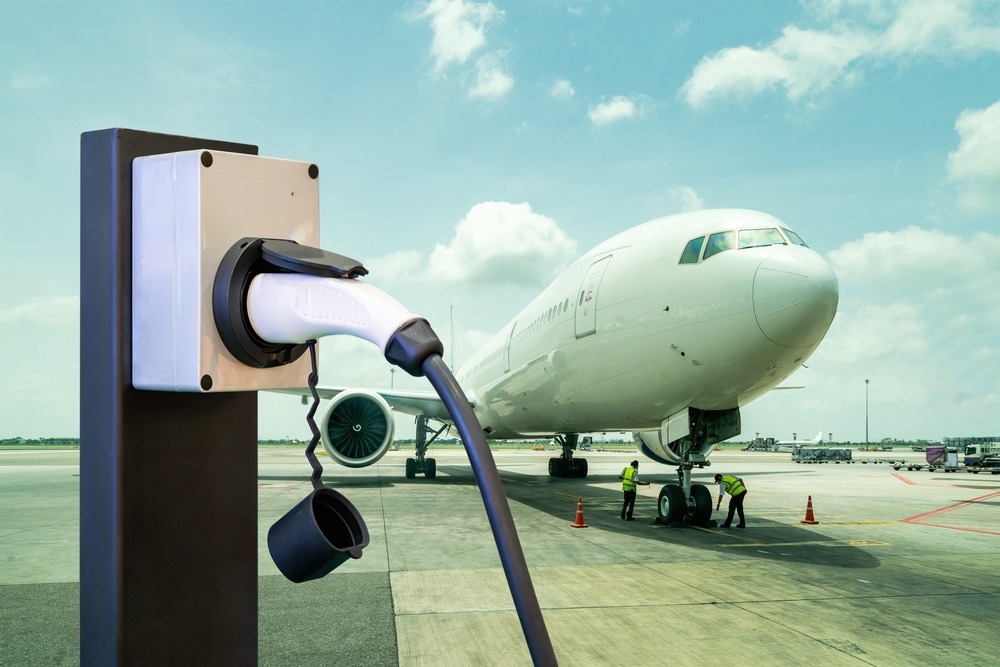While there are currently no commercial electric aircraft projects in the pipeline, several concepts have shown that electric flight is possible. This article examines the latest research in this field and asks if electric aviation will ever take off.

Image Credit: Surasak_Photo/Shutterstock.com
Aviation Needs to Change
Air travel is responsible for 2.4% of all CO2 emissions today, and it has an even larger overall contribution to global warming due to other greenhouse gas (GHG) emissions and contrail cirrus.
Despite the critical need to curb the effects of global warming, demand for air travel has been growing at about 5% a year in the last decade (except during COVID-19 lockdown periods).
Over 4.4 billion passengers took 120,000 daily flights in 2018, and this is expected to increase to 7.2 billion by 2035. This increase would mean that aviation emissions would rise to 11% of anthropogenic GHG.
Reducing emissions in aviation is no simple endeavor. Together with some heavy industries such as mining and shipping, aviation is often referred to as a “hard-to-abate” sector. This is because of the high energy cost required to get planes in the air and moving across vast distances.
Aviation needs technological innovation as a matter of urgency. Electric aircraft (with renewable energy sources) could theoretically cut these emissions dramatically.
Significant Challenges Remain for Electric Aviation
There are several regulatory and technological challenges to overcome for electric aviation to be a reality. This article focuses on technological challenges, which can be summarized under batteries, electric motors, and airframe integration.
All three of these areas are currently immature fields of research and development, with no concept close to commercial viability. As a result, the future of electric aircraft – and whether there even is a future – remains highly uncertain.
The current state-of-the-art battery technology does not deliver enough energy density to be suitable for flight. To power a commercial transport plane with current designs, a typical plane would need to carry nearly 40 times as much battery weight as it could ever take off with. Only 8% of aircraft could feasibly be powered by the most energy-dense batteries available today.
The growing popularity of electric vehicles is leading to rapid advances in battery technology, however, and energy density is improving at a fast rate.
Research concepts such as Bye Aerospace’s eFlyer craft and Pipistrel’s Velis Electro have been proven to fly with battery energy densities of around 260 Wh/kg.
The electric motors in use today are also far too heavy for most applications in aerospace. They are also much less powerful than jet engines, and the heat they generate places an upper limit on the amount of power they can safely output.
Even if these two challenges are overcome, aircraft manufacturers will still need to alter aircraft designs to effectively and efficiently integrate electric propulsion systems. This will require investment in new manufacturing processes, upgraded facilities, and R&D efforts.
How Could Electric Aircraft Become a Commercial Reality?
To bring electric power to aviation in the short term (and the emissions reductions that this would entail), it is necessary to identify a feasible combination of available technologies.
Small-scale aircraft, for example, may benefit from hybrid-electric propulsion systems, which have already contributed to emissions reductions in the automotive industry. However, this kind of system is likely not applicable for large-scale or long-haul flights due to the limitations of current battery technology.
Researchers from UiT The Arctic University of Norway recently put forward a route to electrification in aviation in the short term in a paper in Transportation Engineering. The paper argues that turboelectric designs are the best candidates for a viable electric aircraft in the short term. These systems store energy in fuel and convert some or all of it to electric power to drive propellers.
The development of turboelectric aircraft would pave the way for future all-electric aircraft by first solving the potentially less technologically challenging problems of electric motor development and aircraft integration, without waiting for battery technology to become feasible for flight.
The Future of All-Electric Aircraft
All-electric aircraft configuration is much simpler than hybrid architectures such as turboelectric propulsion. The only power source required would be batteries, which could be charged from renewable energy sources.
All-electric aircraft would create no emissions and, if charged from renewables, use no fossil fuels.
As well as being potentially much less environmentally damaging, all-electric aircraft would be practically silent and cheaper to “fuel” and maintain.
The major hurdle for all-electric aircraft is the limited capacity of current state-of-the-art battery technology. All-electric aircraft concepts are limited to light aircraft covering short distances, unsuitable for commercial air travel.
As well as the Velis Electro mentioned above, Beta Technologies’ Alia-250 and Eviation’s Alice and the Lilium Jet have all demonstrated that electric-powered flight is possible at small scales.
As is the case in many areas of energy innovation, innovations in battery technology may lead to significant and critical disruption in the aircraft industry. They could help save the planet from the worst effects of global warming.
Read more: Rolls-Royce and the Fight for Aircraft Electrification
References and Further Reading
Adu-Gyamfi, B.A., and C. Good (2022) Electric aviation: A review of concepts and enabling technologies. Transportation Engineering. doi.org/10.1016/j.treng.2022.100134.
Brelje, B.J., and J.R.R.A. Martins (2019) Electric, hybrid, and turboelectric fixed-wing aircraft: A review of concepts, models, and design approaches. Progress in Aerospace Sciences. doi.org/10.1016/j.paerosci.2018.06.004.
Gössling, S., S. Dolnicar (2022) A review of air travel behavior and climate change. WIREs Climate Change. doi.org/10.1002/wcc.802.
Timperley, J. (2020) Should we give up flying for the sake of the climate? [Online] BBC. Available at: https://www.bbc.com/future/article/20200218-climate-change-how-to-cut-your-carbon-emissions-when-flying (Accessed on 12 December 2022).
Disclaimer: The views expressed here are those of the author expressed in their private capacity and do not necessarily represent the views of AZoM.com Limited T/A AZoNetwork the owner and operator of this website. This disclaimer forms part of the Terms and conditions of use of this website.